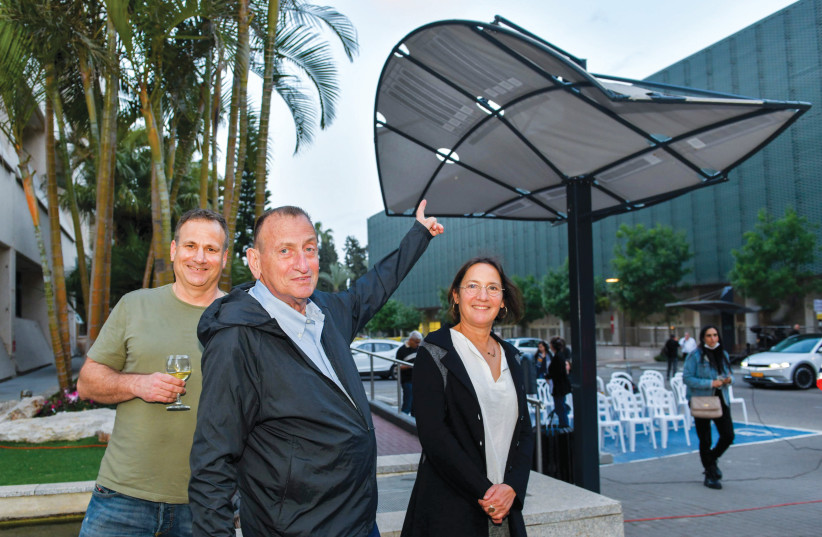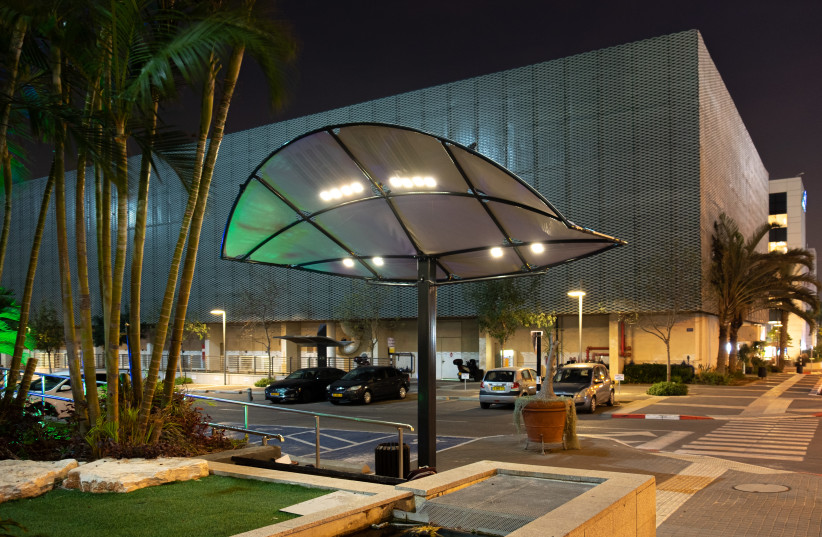The LumiWeave company comes up with an innovative green model to keep our streets cooler and brighter
By BARRY DAVIS
Published: JULY 2, 2022

(photo credit: LumiWeave)
There are some great inventions out there, stuff that could only come from the razor-sharp cutting edge of the very latest technological breakthroughs. But when you break the innovative offerings down, you might be surprised to discover that often, the idea behind it all is pretty simple. That is not to say that anyone can come up with a game-changing scheme that turns our everyday routines on their heads. Then again, it is generally not exactly about reinventing the wheel either.
Anai Green probably gets that. By trade, Green is a product designer with a healthy interest in the environment and our quality of life. She took that wholesome mind-set and ran with it – all the way to the Women for Climate contest – and won it in the process. Her entry into the competition comes from the LumiWeave company she co-founded along with CEO Tal Parnes, and where she serves as CDO.
The contest was organized by Tel Aviv Global & Tourism, a municipal company that operates under the auspices of the office of the mayor of Tel Aviv-Yafo. The municipal outfit is designed to facilitate what it calls “the global quantum leap taken by the city of Tel Aviv-Yafo in creating economic and tourism growth.”
Fight climate change
WOMEN FOR Climate was launched by the global C40 (40 cities) organization, of which the Tel Aviv-Yafo Municipality is a member. C40 was preceded by C20, established in 2005 by then-mayor of London Ken Livingstone. He convened representatives from 18 mega-cities to forge an agreement on collaboratively reducing climate pollution, and hopefully keeping global warming in check.
THE LUMIWEAVE canopy stores solar energy during the day, and provides illumination after dark. (credit: LumiWeave)
In the meantime, close to 100 cities have joined the environmental bandwagon, while leadership of the organization came full geographic circle when current London Mayor Sadiq Khan took over the C40 reins late last year. Addressing the COP26 United Nations climate change conference last year, Khan declared:
“Together we can and we must utilize the power of cities across the globe and continue to lead the charge when it comes to tackling the climate crisis, taking the necessary action now – not in 10, 20 or 30 years’ time – but now.” Bold words indeed but, of course, only time will tell whether Khan and his colleagues are achieving the requisite strides.
“Together we can and we must utilize the power of cities across the globe and continue to lead the charge when it comes to tackling the climate crisis, taking the necessary action now – not in 10, 20 or 30 years’ time – but now.”
London Mayor Sadiq Khan
Green is certainly doing her bit. Her LumiWeave solution was recently installed, for a trial period, at the Park Atidim hi-tech complex in north Tel Aviv. When we met there, I was taken with the simplistic appearance. But I am also quickly disabused of any idea of child’s play. “There are the solar panels, and the electric contacts,” she says, pointing in the direction of the shade-giving canopy that looks a little like a hand glider with hi-tech accessories. “And those white cube shapes – that is what provides light at night.”
And there I had it in a neat nutshell. The world’s first embedded solar power harvesting and illuminating fabric is designed to store solar energy during the day – and there’s no shortage of that in these here parts – and use it to supply street lighting after dark. Simple, and straight to the environmentally-friendly, user-friendly, municipal purse strings-friendly point.
GREEN’S DESIGN takes into account site-specific needs, and the illumination strength can be tweaked accordingly. “This provides 30 lux lighting, but we could go to about 300,” she explains. “It is flexible, also in terms of the illumination.”
That sounds like just the ticket. Many are the times I wonder why there are so many lights out there at night. God knows how much air pollution lighting overload generates, not to mention basic light pollution.
There are manifold disadvantages to meddling with the natural night-follows-day order. We are guilty of operating excessive or poor use of artificial outdoor lighting after dark. That causes mayhem among wildlife, contributes to the increase in carbon dioxide content in the atmosphere, and also adversely affects the quality of our sleep by interfering with the generation of the melatonin hormone while we slumber. And, how many city dwellers get to appreciate the night sky, and the myriad stars twinkling out there?
As the latter part of the company name suggests, the fabric of the shade-light installation is a crucial component for both purposes. “It is quality cloth which is designed to provide shade,” says Green. “It has a longer life than most standard shade material; it is manufactured by a French company.”
The key LumiWeave component, for energy generation, is the photovoltaic (PV) panels slotted into the fabric, along with the LED light source. The solar energy collectors we know from our rooftops, which provide us with hot water, work on similar principles in terms of feeding off solar energy. However, while solar panels convert solar radiation into heat, PV panels are used to harness thermal energy and convert it into electricity.
The design is based on a modular format that allows Green and her colleagues to tailor the unit to the requirements of the location in question. “There is the base unit, with the fabric around it, and then we can just connect more panels, as you need,” she said. “It is flexible. You can form the shading element in any shape you wish.”
GREEN SAYS the LumiWeave unit can be adapted for all sorts of everyday uses. The one I saw over at Atidim, for example, was positioned at the corner of a building next to a bench. While we were there, employees from various local hi-tech companies took advantage of the shade to hang out, smoke, chat and munch away while the LumiWeave fabric provided precious protection from the Middle Eastern sun while storing solar energy to provide them with lighting on their way home in the evening.
The latter is also fashioned based on a malleable application mindset. “The lighting here is dispersed,” Green notes. “That means we can control the strength and spread of the lighting, and it is under shading so none of the lighting is lost. That means we don’t generate light pollution, and we can help to maintain darkness when needed – and maybe allow people to see the stars in the city, too.”
I remarked to Green that presumably, as someone who lives in a rural locale, I am less exposed to the detrimental effects of night lights that burn brightly from sundown through to sunup. “Even if you live on a moshav, anywhere outside urban surroundings, you can suffer all sorts of adverse impact from artificial lighting at night,” she notes. “It not only affects the production of the melatonin hormone (which affects our quality of sleep), but it can weaken the immune system and upset your hormonal state, and the body doesn’t rest at night.”
Clearly, we have a lot to consider when approaching the subject of nocturnal street lighting.
Green envisages, for example, cafés and other eateries where, most of the year, patrons sit outside making good, non-polluting, effective use of the LumiWeave product to provide shade during the day, and illumination after dark. She adds that the low-tech configuration of the innovative structure also means anyone looking to apply the technology can do so without having to meander their way through a red-tape morass.
“We work with 12 volts: low voltage,” she says. “That means we don’t need any special approval from an engineer. In most countries, that starts from 48 volts. I think here, in Israel, you need approval from 24 volts, but we are way below that.”
THERE ARE other advantages to the minimal voltage approach. “In terms of safety, there is no problem with installing this near a source of water,” Green continues. “Think of swimming pools, for example. You can have lighting at night and, of course, shade during the day.” There are legal-bureaucracy benefits to be had here, too.
“Today, you are not allowed to open a new swimming pool in Israel unless at least a third of the pool is shaded. And you are not allowed to run the pool at night if you don’t have illumination,” LumiWeave’s CDO said. “Today, there are hotels that want to keep their pools open at night, and they need special approval, generators and cables. We don’t need any cables.”
Once again, that helps in all sorts of commercial fields. “With cafés and restaurants and such like, for example – municipalities don’t allow them to lay down cables,” Green says, mentioning a possible service which could be put to universal advantage.
“We may install surfaces with USB points where people can charge up their cell phones.” Imagine that. Who hasn’t run out of juice just when they have to make a call? Laptop users, however, won’t be offered charging services. “We won’t have that because computers would use up the stored solar energy far quicker,” Green explains. Naturally, the absence of wiring also keeps the cost of installation down to a minimum, a fraction of what it costs to install standard municipal street lighting.
Besides the low voltage, the LumiWeave creation works on the principle of on-demand. “We have a movement sensor here so that, when there is nobody passing through, the lighting strength reduces to around 40%,” says Green. “Then, when people approach, the illumination rises to 100%. It is not just an on-off situation: It is far more flexible. And we don’t use electricity when there is no need.”
And there’s plenty more where the Park Atidim LumiWeave test run came from. Green says there are plans to install shade-lighting implements around the Sarona area, as well as along the Tel Aviv seafront. Sounds perfectly logical – and definitively ecological.
Green says she and LumiWeave are constantly looking to up the environmentally friendly ante – by replacing the lithium battery currently incorporated into the system with a greener, salt-water battery, for example.
LumiWeave appears to offer a win-win, local weather- and environmentally-friendly solution for all sorts of situations. “I hope we’ll see cafés using this by next year,” says Green. “I can’t see any reason why not.” ■
For more information: www.lumiweave.com
https://www.jpost.com/business-and-innovation/energy-and-infrastructure/article-710869

